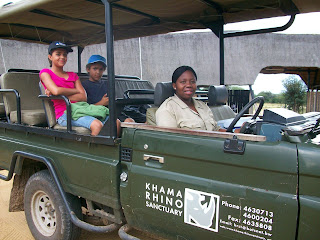




 Again, because the kids had a four day weekend we decided to do some serious traveling this weekend - to the Khama Rhino Sanctuary just north of Serowe - up Sunday and back Monday. It is about a 360 km trip one way on mostly good roads (though only two lanes, one in each direction). I was a little anxious about making the trip alone with the kids in our relatively small car. But it went very well and I now feel ready to travel anywhere in Botswana. One drives straight north from Gaborone on the A1 to Francistown, through Mahalapye, to Palapye. Once in Palapye, one turns left onto the A14 to Serowe. Once through Serowe there is a right turn that leads to Paje (and on to Orapa) and the Rhino Sanctuary. It is completely unmarked until you actually get there. It is a more than 4,300 hectacre sanctuary begun in 1992 in order to provide a safe environment - from poachers - for the few remaining white and black rhinos in Botswana at the time (mostly in Chobe). So, initially a few white rhinos were translocated to the sanctuary and today the population of white rhinos is up to more than 40. There are also three black rhinos and the goal is to rebuild Botswana's black rhino population as well. The sanctuary is located in an area of Kalahari sandveld that is a former cattle post; it is centered around Serowe Pan, a large grass covered depression with several natural water holes. It is an ideal location for white rhinos and other grazing animals. (It is also located next to a large Botswana Defence Force base which provides protection to the sanctuary.)
Again, because the kids had a four day weekend we decided to do some serious traveling this weekend - to the Khama Rhino Sanctuary just north of Serowe - up Sunday and back Monday. It is about a 360 km trip one way on mostly good roads (though only two lanes, one in each direction). I was a little anxious about making the trip alone with the kids in our relatively small car. But it went very well and I now feel ready to travel anywhere in Botswana. One drives straight north from Gaborone on the A1 to Francistown, through Mahalapye, to Palapye. Once in Palapye, one turns left onto the A14 to Serowe. Once through Serowe there is a right turn that leads to Paje (and on to Orapa) and the Rhino Sanctuary. It is completely unmarked until you actually get there. It is a more than 4,300 hectacre sanctuary begun in 1992 in order to provide a safe environment - from poachers - for the few remaining white and black rhinos in Botswana at the time (mostly in Chobe). So, initially a few white rhinos were translocated to the sanctuary and today the population of white rhinos is up to more than 40. There are also three black rhinos and the goal is to rebuild Botswana's black rhino population as well. The sanctuary is located in an area of Kalahari sandveld that is a former cattle post; it is centered around Serowe Pan, a large grass covered depression with several natural water holes. It is an ideal location for white rhinos and other grazing animals. (It is also located next to a large Botswana Defence Force base which provides protection to the sanctuary.)We left home around 7 am and arrived around noon, including a couple of stops. [We did not stop, though should have, at the sign that said we were crossing the Tropic of Capricorn.] Once there, we settled into our very comfortable Chalet G and walked to the restaurant for lunch. At 3:30 we went back to the reception area for a 4 o'clock game drive with Vivian, our driver and guide. We had our best game drive yet, even though it got quite cool, overcast, windy and wet while we were out; luckily we had jackets along with us. The white rhinos are quite stunning; we saw many of them grazing in the pan area. We also saw some that we thought were black rhinos but they were just white ones that had rolled in the mud. In addition to the rhinos we saw zebras, red hartebeest, wildebeest, ostriches, warthogs, impala, kudus, brilliant gemsbok and a jackal. We saw lots of incredible birds including yellow billed hornbills and secretary birds. (Eland continue to elude us; they are the largest antelope followed by kudu and gemsbok, both of which we have seen.) This is definitely a place to which we would like to return!
We did not explore Serowe, home of the Ngwato royal family (Khamas), at all. I felt like I could see vestiges of the homesteads of the past, encircled by hedges, that gave a distinctive feel to what has been called Africa's largest village - with a population today of 90,000. On our next trip we will want to see the rest of Serowe including the Khama III Memorial Museum that also houses the Bessie Head papers and the summit of Thathaganyane Hill where Seretse Khama and other Khama family members are buried. Serowe is where Bessie Head eventually made her home. She wrote about it most notably in Serowe: Village of the Rain Wind.
I love the picture of Mave standing on her hands! So joyful!
ReplyDelete